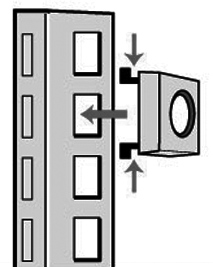Rack Installation Overview
This chapter describes the requirements for installing Riverbed appliances in a rack and includes these sections:
For details on rack installation procedures for SteelFusion Edge appliances, see the SteelFusion Edge Hardware and Maintenance Guide.
Rack installation safety guidelines
When installing the appliance in a rack, follow these guidelines:
• Do not block or cover the openings to the appliance.
• Never push objects of any kind through openings in the appliance. Dangerous voltages might be present.
• Do not use conductive foreign objects; they can produce a short circuit and cause fire, electric shock, or damage to your appliance.
• Lift appliances using both hands and with your knees bent.
• Observe local occupational health and safety requirements and guidelines for manual materials handling.
• Do not attempt to move a rack by yourself; at least two people are needed to move a rack.
• Do not attempt to move a rack on an incline that is greater than 10 degrees from the horizontal.
• Installing components in a rack without the front and side stabilizers can cause the rack to tip over. Always install rack stabilizers before you install components in a rack.
• Make sure the rack is properly secured to the floor or ceiling.
• Always load the rack from the bottom. Load the heaviest component in the rack first.
• Make sure racks are coupled together if it is a multiple-rack installation.
• Make sure the rack is level and stable before installing an appliance in the rack.
• Make sure the leveling jacks are extended to the floor.
• Make sure the full weight of the rack rests on the leveling jacks.
• Make sure the rack is level and stable before pulling a component out of the rack.
• Make sure only one component is extended at a time. A rack might become unstable if more than one component is extended.
• Ensure that there is adequate airflow in the rack. Improper installation or restricted airflow can damage the appliance.
• The rack can’t have solid or restricted airflow doors. You must use a mesh door on the front and back of the rack or remove the doors to ensure adequate airflow to the appliance.
• The rack width and depth must allow for proper serviceability and cable management.
• Ensure that there is adequate airflow in the rack. Improper installation or restricted airflow can damage the appliance.
• Models 150, 250, 550, CX255, CX555, CX570, CX755, CX770, SMC9000, and SCC1000 are designed for the desktop. If you install them in a rack, do not place equipment on top of the appliance as it restricts airflow and might cause damage to the appliance.
• Make sure the product is properly mated with the rails. Products that are improperly mated with the rails might be unstable.
• Verify that the AC power supply branch circuit that provides power to the rack isn’t overloaded. Overload power increases the risk of personal injury, fire, or damage to the appliance. The total rack load should not exceed 80 percent of the branch circuit rating. Consult the electrical authority having jurisdiction over your facility wiring and installation requirements.
• The 1U, 2U, and 3U appliances produce front-to-back cooling airflow that requires an unobstructed airflow to the fan housing. Do not mount the appliance near other electronic devices that produce back-to-front airflow.
• The SteelHead desktop x50 appliances require sideways airflow. Do not block the sides.
• The SteelHead x50 require air-convection cooling. If these models are installed in a rack, use the Riverbed provided rack-mount kit.
• The appliance is for use only in a machine room or IT room.
• Make sure that the area in which you install the appliance is properly ventilated and climate controlled.
• Ensure the voltage and frequency of your power source match the voltage and frequency inscribed on the electrical rating label of the appliance.
• Do not install the appliance in or near a plenum, air duct, radiator, or heat register.
• Never use the appliance in a wet location.
For detailed safety information, see the Safety and Compliance Guide.
Required tools and equipment
You need the following tools and equipment to mount the appliance in a rack:
• A standard Telco-type rack
• A standard Phillips-head screwdriver
• The enclosed screw kit
• The enclosed short rack adapters (if needed)
• The enclosed square post-hole adapters (if needed)
• The enclosed brackets (if needed)
If your appliance is missing any components, contact Riverbed Support for replacement parts at
https://support.riverbed.com.Square post-hole adapters
Rack cabinets can have square or circular holes in the vertical posts. If necessary, to accommodate standard screws you can convert the square post-holes to circular holes using the included square post-hole adapters.
To convert a square post-hole to fit a standard screw
• Press together the top and bottom of the square post-hole adapter and push it into the square hole on the inside of the rack post.
Figure 1‑1. Installing a square post-hole adapter



